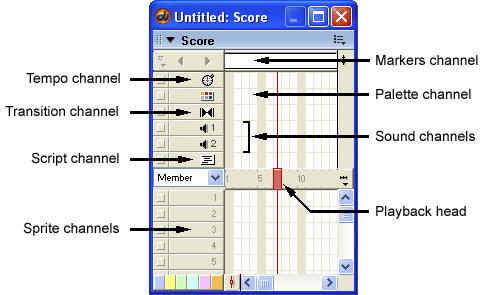The Director Interface

Adobe Director (previously Macromedia) is a multimedia authoring program capable of creating
Shockwave content for the web or self-contained executables for hard drive,
DVD or CD-ROM.
Director's interface is designed around a movie / theatre metaphor. The
media elements in a Director project are called the Cast members,
they interact on a Stage, the Score keeps track of the media
over time, and you, as the multimedia designer, become the director of a
movie.
A movie is the term used for a multimedia piece you create with Director.
Like animated motion pictures, Director movies can contain animation, sound,
special effects and even video. They also have an added dimension not capable
in a motion picture, interactivity. Interactivity means that the movie responds
to the choices you make. Director movies can be as simple as an animated
logo, or as complex as an online chat room or game. Every movie has several
unique qualities, including stage size, position, colour and much more.
You specify the movie properties (as well as properties for other elements)
in the Property Inspector.
Director's User Interface (UI) is made up of a number of windows (also called
panels). These windows can be grouped together to form
tabbed panel groups. They can also be docked
(linked) together or, in the case on some panel types, docked to the background
(docking channels).
When creating and editing movies, you typically work with four key windows
in Director's work area. These are: the Stage, the rectangular area
where the movie plays; one or more Cast windows, where all the movie's
media elements are stored; the Score, where the movie is assembled
and the Property Inspector, which allows you to set the properties
of various aspects of your movie. The Control Panel is
another useful window, providing controls for playing movies.
At the top of this page is the default workspace (panel set) layout. You can create and save
your own panel set layout from Windows > Panel Sets >
Save Panel Set Layout. You can also go back to the default
layout at any time following the same process.
In the default panel set layout (as in the screenshot), the Score and Cast are
docked together. The Tool Palette is docked to the left
docking channel. In the right docking channel, we see the Property
Inspector. Docked underneath is the Library Palette
in a tabbed panel group with the Behavior Inspector and
Object Inspector. The Stage has a Control
Toolbar built into the bottom of the window. This toolbar is a
downsized version of the Control Panel. You can remove
the Control Toolbar by choosing View > Control
Toolbar (the Stage window must be active
to allow you to do this).
There are two types of windows in Director: document windows
and tool windows. Document windows are used to create or
edit content. Tool windows allow you to view or modify properties of this
content. The Paint window is a document window, allowing
you to create and edit images. The Property Inspector is
a tool window that allows you to view properties of that image member (in
the member tab). Some cast member properties displayed in the Property Inspector
are not editable, like the creation date, while others can be modified.
The Stage, Score and Cast are document windows. The Tool Palette, Control
Panel are tool windows.
Main Windows Summary
The Score organises and controls a movies
content over time in channels and frames (see below). It also
controls special effects, such as transitions.
The Cast window displays all the media
that make up a movie, such as images, text, sounds, digital video. It can
be viewed as series of icons (as shown in the screen shot above) or as a
text list when in list view mode.
The Stage is the 'screen' on which Director
movies are projected. It is used to determine where all the visible media
in a movie appear.
The Property Inspector displays the
properties of various elements of a movie, such as cast members, sprites,
or the movie itself.
The Control Panel provides a set of controls
similar to those on a VCR to do things such as pause, play or rewind a movie.
The Score is made up of:
Channels - rows that contain effects (timing
controls, transitions, sounds) and sprites (visual media).
Sprites are instances of cast members on the Stage. The sprite channels
represent how sprites are displayed and controlled over time. Sprite channels
are numbered, allowing visible media to be layered on the Stage. Sprite
channels can also be named (in MX 2004).
The Score can be minimised or maximised by clicking the Hide/Show
Effects Channels icon. ![]()
Frames - numbered columns. A frame
is a single step, or moment in time in the movie, like frames in a traditional
film. The playback head shows which frame is currently displayed
on the Stage. By clicking any frame in the Score, the playback head will
move to that location in the movie.


